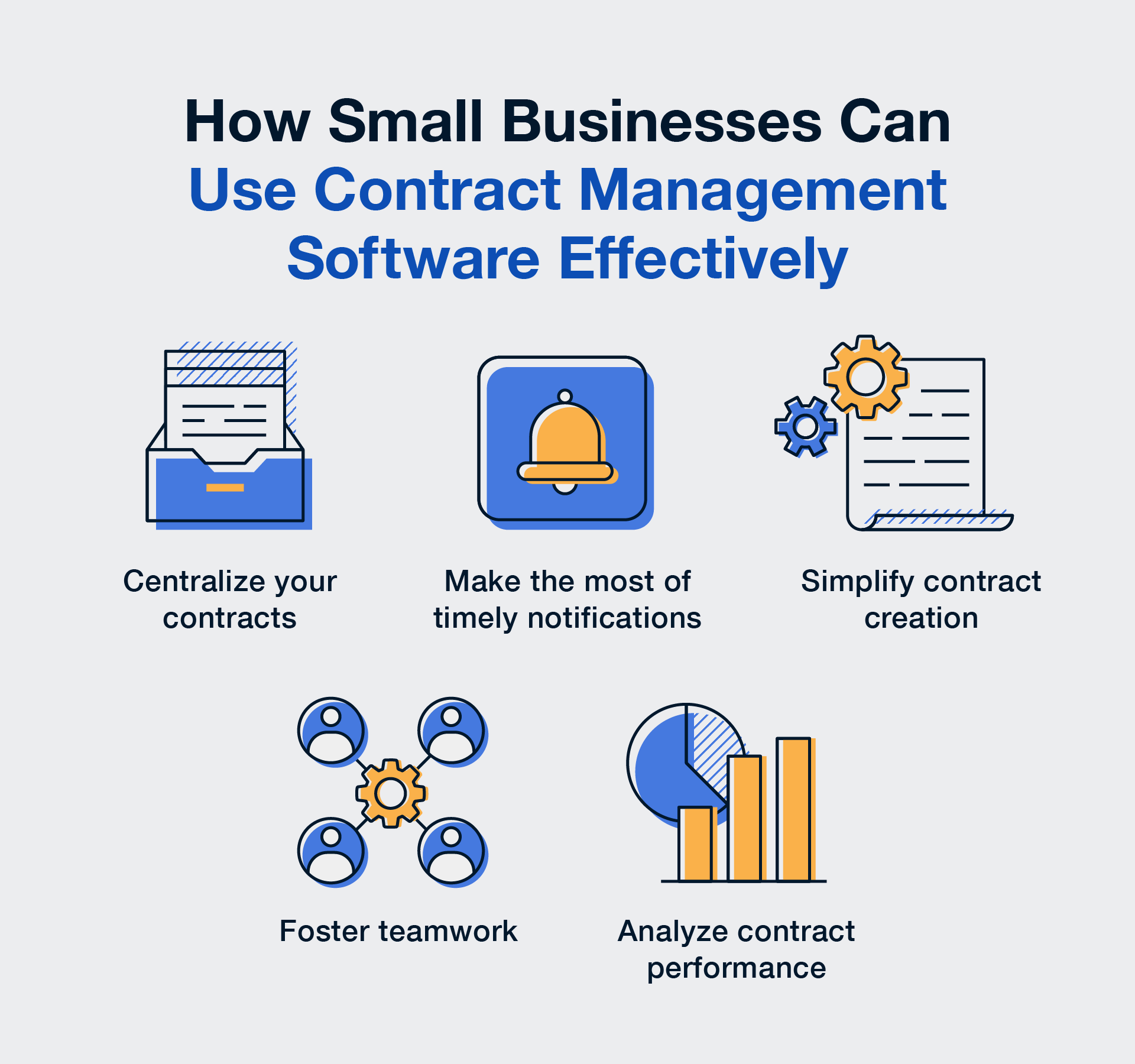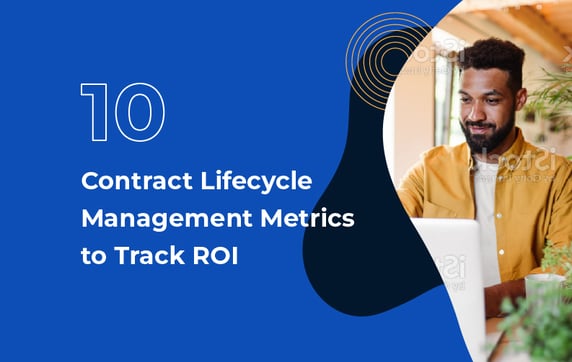When you’re charged with making data-driven decisions regarding whether or not your company is earning a return on investment (ROI) from your current contract management process, it’s critical to leverage the data that matters most to the task at hand.
In this post, we outline the top 10 contract lifecycle management metrics to help you calculate ROI and build a compelling business case for contract management software.
Setting Meaningful Contract Management KPIs
Key performance indicators (KPIs) are used to measure effectiveness and efficiency. They’re meant to tell you more than if things are just getting done: they’re meant to tell you how well they’re getting done.
There are two types of KPIs to consider: strong and soft. Strong KPIs are tied to measurable metrics and outcomes, while soft KPIs are used to evaluate experience and satisfaction. In contract management, strong KPIs are vital to understanding how contracts are affecting things such as sales revenue, brand reputation, and legal expenses.
To uncover the metrics that will be meaningful for your business, look for any recurring issues in your company’s contract lifecycle. If you have contract management goals documented, you can work backwards to set up meaningful KPIs that tie back to your goals.
For example, if you have a goal to shorten time to signature, you can establish a KPI that tracks the average length of time it takes to move a contract through your pre-signature contract process. If your company’s goal is to increase revenue by a certain percentage over the next fiscal year, KPIs around the volume and value of active contracts will be key to measuring whether or not this goal is being met.
10 Contract Management KPIs Every Business Should Track
To jumpstart your list of meaningful KPIs, we’ve compiled a list of must-track contract lifecycle management metrics:
1. Inbound Contract Requests
This metric measures not only the volume of contract requests your legal inbound client services team is fielding, but also the quality of those requests. Tracking the number of incoming contract requests is helpful, but analyzing things a step further to understand how those requests are being submitted — via email, phone, or in person — offers even more valuable insight.
Tracking the number of requests that move forward versus those that are declined or rejected, based on source, will help you gauge the effectiveness of your legal inbound client services team’s qualification process through various channels.
By getting more granular and tracking the exact reasons qualified contracts didn’t move forward, you’re able to spot hiccups in your inbound process and solve for them. Did the rejected requests not have enough information? Is your team not vetting potential clients properly? These types of contract management KPIs can help you identify recurring issues that influence your company’s contract acceptance rate.
2. Contract Acceptance Rate
The average number of contracts accepted versus the number that are declined or rejected is your contract acceptance rate. This metric provides a pre-signature contract management health check at a glance by shining a spotlight on the outcomes of the process.
3. Contracts in Process
Tracking the number of contracts in process, or your company’s contract volume, allows you to evaluate workload analytics as well as purchasing and sales activities.
For example, when it comes to personnel workloads, tracking contracts in process can help you determine whether your company has adequate staffing and resources for each stage of the contract lifecycle, from the initial request to the approval, signature, and beyond.
4. Renewals
Some of the more common contract lifecycle management metrics related to renewals include:
- Overall percentage of contracts renewed
- Number of auto-renewals
- Value of contracts renewed or nonrenewed
- Number of contracts renewed according to your company’s policies and standard renewal process
For this last metric, you’ll need the ability to record whether a contract was auto-renewed, renewed with action on your team’s part, or terminated. This data is easy to collect when you have contract management software with reporting capabilities.
On the flip-side of the renewals KPI, you’ll want to track failed contract renewals. Expired contracts can tell you a lot about how your business is performing. The number of failed renewals can be tracked by auto-renewals and standard term renewals, as well as by-products, services, and locations (if you have more than one).
If the metrics for failed contract renewals seem high, or if the ratio of failed renewals to contracts in process isn’t where you’d like it to be, this KPI helps identify a need for better preparation so you can make an effective case for clients to renew with your company. Establishing pre-set alerts as renewal dates approach provides your team ample time to prepare a pitch, sell add-on services, or renegotiate terms.
While attrition is a part of any business, you can lower the cost of customer acquisition by retaining more clients. If you work in an industry where high attrition is normal, you can still track the number of non-renewals that could be avoidable or regrettable.
5. Contract Value Metrics
If you want to gauge the ROI of your company’s contract management process, there’s no better way to do so than by looking at contract value metrics. (We’re talking dollars and cents here!)
- Annual Contract Value (ACV) – This is the total revenue created each year by each contract. For example, a two-year contract signed for $50,000 provides an ACV of $25,000. To get the average ACV, sum up the ACVs by contract, and then divide the total by the number of contracts managed.
- Total Contract Value (TCV) – TCV measures how much a fully executed contract is worth. To calculate TCV, multiply the monthly recurring revenue (MRR) from the contract by the contract term length, and then add in any contract fees. For example, if a two-year customer contract has an MRR of $1,000, plus a $100 onboarding fee, the TCV for that contract would be ($1,000 x 24 months) + $100 = $24,100.
- Annual Recurring Revenue (ARR) – To calculate ARR, divide the total contract value by the number of relative years. For example, if a customer signs a five-year contract for $10,000, divide $10,000 (contract cost) by five (number of years) for an ARR of $2,000 per year. If a customer declines to renew a $10,000 contract over five years, divide $10,000 (contract cost) by five (number of years) for an ARR decrease of $2,000.
6. Missed, Outstanding, and Completed Obligations
Tracking missed and outstanding obligations is critical for your company in assessing the repercussions of contract risk. Missed obligations can result in terminated contracts or putting your company in the position of being out of compliance. Making improvements in these areas will save time, money, and even your reputation.
The goal of these types of KPIs are to track the number of missed, outstanding, and completed obligations and evaluate the resulting ratios. You can drill down further and compare the ratios from one department or project to the next, or track the KPI for different company locations or subsidiaries.
Another way to track this KPI is to take all the terminated contracts and total up the number of missed milestones. Or, if you want to prevent contracts from being terminated in the first place, track the number of contracts approaching renewal with outstanding obligations.
7. Approved Language Use
This KPI tracks the number of contracts drafted with language approved by your legal department. By comparing this number with the number of contracts drafted by third parties, you can see how many contracts are truly established on your terms and work toward decreasing the number of third-party contracts your company signs. When you use your own contracts, you minimize your company’s exposure to contract risk.Not only can a contract management software solution make it easy to track this KPI, it can ensure your team works from standardized contracts and pre-approved clauses.
8. Contracts Executed with E-Signatures
For most organizations, e-signatures shorten the amount of time needed to approve, sign, and execute a contract. If your company wants to increase the number of contracts being signed electronically to capitalize on those time savings, you’ll want to track this metric, compare it with the number of contracts signed using pen and paper, and then adjust your process to encourage (if not mandate) e-signature usage.
9. Approval Delays
This KPI helps track overall delays in contract approvals. More precisely, it tracks approval delays caused on your end versus approval delays due to the other party.
If approval delays are problematic on your end, take a look at where bottlenecks are occurring. Every day a contract isn’t signed by both parties can result in lost revenue, so you can add to your company’s bottom line simply by expediting the approval process.
When your data shows delays on the third-party or client side, implement protocols for handling common issues. Should your team follow up more aggressively? Could the process be expedited by using e-signature?
10. Average Contract Lifecycle
Knowing how long it takes to get from the first point of contact to an executed contract helps illustrate the efficiency (or lack thereof) of your process. Start by calculating your current contract lifecycle time, and then talk with your team about whether this metric is satisfactory, or if improvements can be made.
One way to gauge contract lifecycle time is to compare the date the first draft was sent back to the organization vs. sent out. This can be helpful in measuring turn time from request to first meaningful action by legal.
Average contract lifecycle is another KPI where you can get granular and track numbers based on type of contract, department, subsidiary, location, etc. If some locations have shorter contract lifecycles than others, what are those locations doing differently? If one department is taking longer to fulfill its obligations, does the team need more support staff? Taking a hard look at the data, asking questions, and taking action accordingly will improve your operations.
Seizing Opportunities for Improvement
The KPIs outlined above should provide a strong foundation for determining the ROI of your current contract management process. Where opportunities for improvement arise, implementing a contract management software like ContractSafe can be a simple solution.
Wanting to improve compliance with deadlines for contract approvals, obligations, renewals, and terminations? ContractSafe’s date alerts put you in control of your contract's lifespans.
Do you need to group contracts by inbound request method or lifecycle stage? ContractSafe’s customizable label statuses make it simple to track documents based on your own internal processes.
Looking for better contract version control to ensure use of the latest language approved by your legal department? ContractSafe does that, too! With a full audit trail, you’ll always know who uploaded the current version or made changes to it.
Does all this sound too good to be true? It’s not. But we get it — seeing is believing, so request your free trial and put ContractSafe to the test today.

















